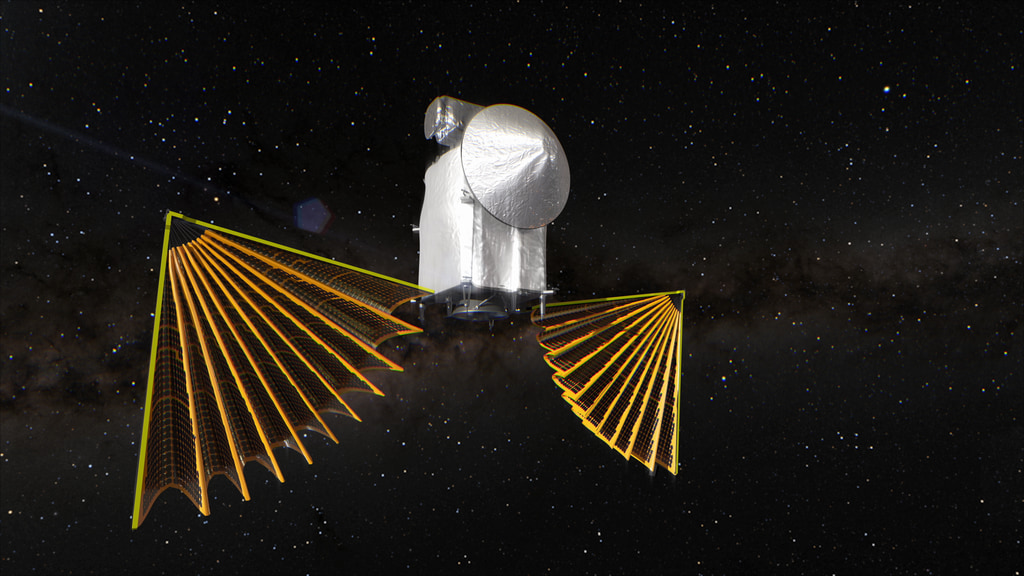Balky solar array still troubling NASA's Lucy asteroid probe

NASA's Lucy asteroid probe continues to fly with a partially unfurled wing.
Shortly after Lucy's Oct. 16 liftoff, mission team members determined that one of the spacecraft's two huge solar arrays had not fully deployed. Lucy's handlers have been working hard on the problem, but it remains unsolved at present.
"Analysis indicates that the array is between 75% and 95% deployed. It is currently being held in place by a lanyard, specifically designed to help unfurl the arrays during deployment," NASA officials wrote in an update on Wednesday afternoon (Oct. 27).
Related: Meet the 8 asteroids NASA's Lucy spacecraft will visit
"An anomaly response team continues to work on establishing what caused the solar array to not fully deploy," NASA officials added. "NASA and SwRI are evaluating a range of options, including the possibility of leaving the array in its current state. Any attempt to safely redeploy the array would occur no earlier than Nov. 16."
SwRI is the Southwest Research Institute in Boulder, Colorado, the home base for Lucy's principal investigator, Hal Levison.
Aside from the solar-array problem, Lucy and its systems are in good shape, NASA officials said. The spacecraft continues to check off milestones and has performed several small maneuvers as planned. It's currently in cruise mode, "which is the standard flight mode for outbound flight and allows for substantial autonomy for the spacecraft," NASA officials wrote in the update.
Breaking space news, the latest updates on rocket launches, skywatching events and more!
Another big milestone is scheduled for Friday (Oct. 29). On that day, the Lucy team plans to point the spacecraft toward Earth, so they can prepare to start checking out its scientific instruments, NASA officials wrote today.
Lucy is embarked on a long and ambitious deep-space trek that will see it fly by eight different asteroids between 2025 and 2033. Seven of those space rocks are Trojans, little-studied asteroids that zoom around the sun in Jupiter's orbit, but ahead of or behind the giant planet. The eighth resides in the main asteroid belt between Mars and Jupiter.
Sunlight is about 25 times weaker in the realm of the Trojans than the flow we experience here on Earth, so Lucy needs huge solar arrays to soak it up. Each of its two panels is 23.9 feet (7.3 meters) wide when fully deployed.
Lucy will visit more asteroids than any other spacecraft, if all goes according to plan. And it will set another record as well: No solar-powered spacecraft has ever operated as far from the sun as Lucy aims to, although NASA's Jupiter-orbiting Juno probe comes close.
Mike Wall is the author of "Out There" (Grand Central Publishing, 2018; illustrated by Karl Tate), a book about the search for alien life. Follow him on Twitter @michaeldwall. Follow us on Twitter @Spacedotcom or Facebook.

Michael Wall is a Senior Space Writer with Space.com and joined the team in 2010. He primarily covers exoplanets, spaceflight and military space, but has been known to dabble in the space art beat. His book about the search for alien life, "Out There," was published on Nov. 13, 2018. Before becoming a science writer, Michael worked as a herpetologist and wildlife biologist. He has a Ph.D. in evolutionary biology from the University of Sydney, Australia, a bachelor's degree from the University of Arizona, and a graduate certificate in science writing from the University of California, Santa Cruz. To find out what his latest project is, you can follow Michael on Twitter.
